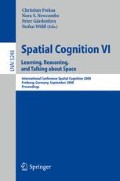Abstract
Spatial abstraction empowers complex agent control processes. We propose a formal definition of spatial abstraction and classify it by its three facets, namely aspectualization, coarsening, and conceptual classification. Their characteristics are essentially shaped by the representation on which abstraction is performed. We argue for the use of so-called aspectualizable representations which enable knowledge transfer in agent control tasks. In a case study we demonstrate that aspectualizable spatial knowledge learned in a simplified simulation empowers strategy transfer to a real robotics platform.
Access this chapter
Tax calculation will be finalised at checkout
Purchases are for personal use only
Preview
Unable to display preview. Download preview PDF.
References
Hobbs, J.R.: Granularity. In: Proceedings of the Ninth International Joint Conference on Artificial Intelligence (IJCAI), pp. 432–435 (1985)
Bittner, T., Smith, B.: A taxonomy of granular partitions. In: Montello, D. (ed.) Spatial Information Theory: Cognitive and Computational Foundations of Geographic Information Science (COSIT), pp. 28–43. Springer, Berlin (2001)
Mackaness, W.A., Chaudhry, O.: Generalization and symbolization. In: Shekhar, S., Xiong, H. (eds.) Encyclopedia of GIS (2008)
Klippel, A., Richter, K.F., Barkowsky, T., Freksa, C.: The cognitive reality of schematic maps. In: Meng, L., Zipf, A., Reichenbacher, T. (eds.) Map-based Mobile Services – Theories, Methods and Implementations, pp. 57–74. Springer, Berlin (2005)
Herskovits, A.: Schematization. In: Olivier, P., Gapp, K.P. (eds.) Representation and Processing of Spatial Expressions, pp. 149–162. Lawrence Erlbaum Associates, Mahwah (1998)
Stell, J.G., Worboys, M.F.: Generalizing graphs using amalgamation and selection. In: Güting, R.H., Papadias, D., Lochovsky, F. (eds.) SSD 1999. LNCS, vol. 1651, pp. 19–32. Springer, Heidelberg (1999)
Bertel, S., Vrachliotis, G., Freksa, C.: Aspect-oriented building design: Toward computer-aided approaches to solving spatial contraint problems in architecture. In: Allen, G.L. (ed.) Applied Spatial Cognition: From Research to Cognitive Technology, pp. 75–102. Lawrence Erlbaum Associates, Mahwah (2007)
Moravec, H.P., Elfes, A.E.: High resolution maps from wide angle sonar. In: Proceedings of the IEEE International Conference on Robotics and Automation (ICRA), St. Louis, MO (1985)
Gutmann, J.S., Weigel, T., Nebel, B.: A fast, accurate and robust method for self-localization in polygonal environments using laser range finders. Advanced Robotics 14(8), 651–667 (2001)
Roberts, F.S.: Tolerance geometry. Notre Dame Journal of Formal Logic 14(1), 68–76 (1973)
Sutton, R.S., Barto, A.G.: Reinforcement learning: an introduction. In: Adaptive Computation and Machine Learning. MIT Press, Cambridge (1998)
Konidaris, G.D., Barto, A.G.: Building portable options: Skill transfer in reinforcement learning. In: Proceedings of the Twentieth International Joint Conference on Artificial Intelligence (IJCAI) (2007)
Taylor, M.E., Stone, P.: Cross-domain transfer for reinforcement learning. In: Proceedings of the Twenty Fourth International Conference on Machine Learning (ICML 2007), Corvallis, Oregon (2007)
Torrey, L., Shavlik, J., Walker, T., Maclin, R.: Skill acquisition via transfer learning and advice taking. In: Fürnkranz, J., Scheffer, T., Spiliopoulou, M. (eds.) ECML 2006. LNCS (LNAI), vol. 4212, pp. 425–436. Springer, Heidelberg (2006)
Watkins, C., Dayan, P.: Q-learning. Machine Learning 8, 279–292 (1992)
Thrun, S., Schwartz, A.: Finding structure in reinforcement learning. In: Tesauro, G., Touretzky, D., Leen, T. (eds.) Advances in Neural Information Processing Systems: Proceedings of the 1994 Conference, vol. 7. MIT Press, Cambridge (1995)
Frommberger, L.: A generalizing spatial representation for robot navigation with reinforcement learning. In: Proceedings of the Twentieth International Florida Artificial Intelligence Research Society Conference (FLAIRS 2007), Key West, FL, USA, pp. 586–591. AAAI Press, Menlo Park (2007)
Goyal, R.K., Egenhofer, M.J.: Consistent queries over cardinal directions across different levels of detail. In: Tjoa, A.M., Wagner, R., Al-Zobaidie, A. (eds.) Proceedings of the 11th International Workshop on Database and Expert System Applications, Greenwich, UK, pp. 867–880 (2000)
Schlieder, C.: Representing visible locations for qualitative navigation. In: Carrete, N.P., Singh, M.G. (eds.) Qualitative Reasoning and Decision Technologies, Barcelona, Spain, pp. 523–532 (1993)
Frommberger, L.: Generalization and transfer learning in noise-affected robot navigation tasks. In: Neves, J., Santos, M.F., Machado, J.M. (eds.) EPIA 2007. LNCS (LNAI), vol. 4874, pp. 508–519. Springer, Heidelberg (2007)
Talmy, L.: How language structures space. In: Pick Jr., H.L., Acredolo, L.P. (eds.) Spatial Orientation: Theory, Research, and Application. Plenum, New York (1983)
Porta, J.M., Celaya, E.: Reinforcement learning for agents with many sensors and actuators acting in categorizable environments. Journal of Artificial Intelligence Research 23, 79–122 (2005)
Author information
Authors and Affiliations
Editor information
Rights and permissions
Copyright information
© 2008 Springer-Verlag Berlin Heidelberg
About this paper
Cite this paper
Frommberger, L., Wolter, D. (2008). Spatial Abstraction: Aspectualization, Coarsening, and Conceptual Classification. In: Freksa, C., Newcombe, N.S., Gärdenfors, P., Wölfl, S. (eds) Spatial Cognition VI. Learning, Reasoning, and Talking about Space. Spatial Cognition 2008. Lecture Notes in Computer Science(), vol 5248. Springer, Berlin, Heidelberg. https://doi.org/10.1007/978-3-540-87601-4_23
Download citation
DOI: https://doi.org/10.1007/978-3-540-87601-4_23
Publisher Name: Springer, Berlin, Heidelberg
Print ISBN: 978-3-540-87600-7
Online ISBN: 978-3-540-87601-4
eBook Packages: Computer ScienceComputer Science (R0)

